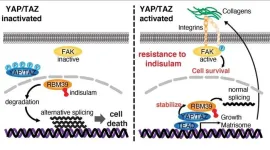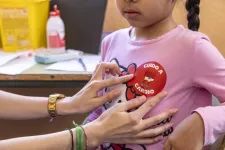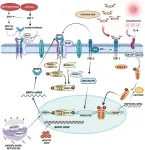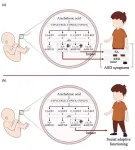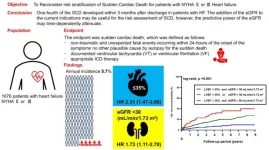(Press-News.org) Researchers at UC San Francisco have found a link between following a diet that is rich in vitamins and minerals, especially one without much added sugar, and having a younger biological age at the cellular level.
They looked at how three different measures of healthy eating affected an “epigenetic clock” – a biochemical test that can approximate both health and lifespan – and found that the better people ate, the younger their cells looked. Even when people ate healthy diets, each gram of added sugar they consumed was associated with an increase in their epigenetic age.
“The diets we examined align with existing recommendations for preventing disease and promoting health, and they highlight the potency of antioxidant and anti-inflammatory nutrients in particular,” said Dorothy Chiu, PhD, a postdoctoral scholar at the UCSF Osher Center for Integrative Health and first author of the study, which appears July 29 in JAMA Network Open. “From a lifestyle medicine standpoint, it is empowering to see how heeding these recommendations may promote a younger cellular age relative to chronological age.”
The study is one of the first to show a link between added sugar and epigenetic aging, and the first to examine this link in a heterogenous group of women – both Black and white – in midlife. Most studies on the topic have involved older white participants.
The study helps deepen our understanding of why sugar is so detrimental to health, added study co-senior author Elissa Epel, PhD, a UCSF professor in the Department of Psychiatry and Behavioral Sciences.
“We knew that high levels of added sugars are linked to worsened metabolic health and early disease, possibly more than any other dietary factor,” Epel said. “Now we know that accelerated epigenetic aging is underlying this relationship, and this is likely one of many ways that excessive sugar intake limits healthy longevity.”
Women in the study reported consuming an average of 61.5 grams of added sugar per day, though the range was large: from 2.7 to 316 grams of added sugar daily. A bar of milk chocolate has about 25 grams of added sugar, while a 12-ounce can of cola has about 39 grams. The U.S. Food and Drug Administration recommends adults consume no more than 50 grams of added sugar per day.
A nutrient-based approach
For the cross-sectional study, researchers analyzed food records from 342 Black and white women with a mean age of 39 years from Northern California. Then, they compared their diets with epigenetic clock measures, which were derived from saliva samples.
Researchers scored the women’s diets to see how they compared to a Mediterranean-style diet rich in anti-inflammatory and antioxidant foods and then to a diet linked to lower risk for chronic disease.
Finally, they scored the women’s diets against a measure they created called the “Epigenetic Nutrient Index (ENI)”, which is based on nutrients (not foods) that have been linked to anti-oxidative or anti-inflammatory processes and DNA maintenance and repair. These include Vitamins A, C, B12 and E, folate, selenium, magnesium, dietary fiber and isoflavones.
Adherence to any of the diets was significantly associated with lower epigenetic age, with the Mediterranean diet having the strongest association.
The researchers examined sugar intake separately and found that consuming foods with added sugar was associated with accelerated biological aging, even in the presence of an otherwise healthy diet.
“Given that epigenetic patterns appear to be reversible, it may be that eliminating 10 grams of added sugar per day is akin to turning back the biological clock by 2.4 months, if sustained over time,” said co-senior author Barbara Laraia, PhD, RD, a UC Berkeley professor in the Food, Nutrition and Population Health program. “Focusing on foods that are high in key nutrients and low in added sugars may be a new way to help motivate people to eat well for longevity.”
Co-Authors: Elissa Hamlat, PhD, of UCSF and Joshua Zhang, PhD of UCLA.
Funding: Eunice Kennedy Shriver National Institute of Child Health and Human Development (R01HD073568); National Heart, Lung, and Blood Institute (R56HL141878); National Institute on Aging (R56AG059677 and R01AG059677]; Lisa Stone Pritzker Foundation; National Center for Complementary & Integrative Health (T32AT0039970).
Disclosures: None.
About UCSF Health: UCSF Health is recognized worldwide for its innovative patient care, reflecting the latest medical knowledge, advanced technologies and pioneering research. It includes the flagship UCSF Medical Center, which is a top-ranked hospital, as well as UCSF Benioff Children’s Hospitals, with campuses in San Francisco and Oakland; Langley Porter Psychiatric Hospital; UCSF Benioff Children’s Physicians; and the UCSF Faculty Practice. These hospitals serve as the academic medical center of the University of California, San Francisco, which is world-renowned for its graduate-level health sciences education and biomedical research. UCSF Health has affiliations with hospitals and health organizations throughout the Bay Area. Visit https://www.ucsfhealth.org/. Follow UCSF Health on Facebook or on Twitter
###
Follow UCSF
ucsf.edu | Facebook.com/ucsf | Twitter.com/ucsf | YouTube.com/ucsf
END
Healthy diet with less sugar is linked to younger biological age
2024-07-29
ELSE PRESS RELEASES FROM THIS DATE:
From tree holes to trash
2024-07-29
A team of biologists from the University of Delhi and Zoological Survey of India, Harvard University, and the University of Minnesota has discovered a unique breeding behavior in a species of frog endemic to the Andaman Islands of India. In a new study published in the Harvard Museum of Comparative Zoology’s journal Breviora, scientists describe a combination of traits that makes reproduction in this frog unique.
The Andamanese Charles Darwin’s frog, Minervarya charlesdarwini, belongs to the family Dicroglossidae, a large radiation of Asian frogs that comprises over ...
Despite risk, many unsure of temperature to heat food to prevent illness
2024-07-29
PHILADELPHIA – With bird flu virus detected in cow’s milk, U.S. health authorities have warned the public against potential sources of exposure, including drinking raw or unpasteurized milk, and have reiterated a general warning that consuming uncooked or undercooked poultry or beef products can make you sick.
Relatively few people say they drink raw milk. Only 3% of U.S. adults report having consumed raw milk in the past 12 months, while 4% were not sure whether they had, according to a new nationally representative Annenberg Public Policy Center health survey of nearly 1,500 empaneled U.S. adults conducted in July.*
But many more people say they do ...
YAP/TAZ interactions can confer resistance to anti-tumor drug indisulam
2024-07-29
In a healthy human body, tissue growth and development are coordinated by many different mechanisms. Within our bodies, these mechanisms regulate the healthy growth of cells, limit their size and number, and control the timing of cell death through apoptosis. However, when these regulatory pathways are altered, or break down, cell growth and proliferation may increase beyond what is safe and this can lead to cancer. One critical cell growth regulatory mechanism is the Hippo signaling pathway. This pathway regulates the expression of several genes that control cell proliferation ...
Asbestos-related cancer: exaggerated risk perception
2024-07-29
Asbestos, a group of naturally occurring fibrous minerals, has been historically used for its durability and resistance to heat. Despite its advantageous properties, asbestos is a well-documented carcinogen, linked to diseases such as lung cancer (LC) and malignant pleural mesothelioma (MPM). The controversy surrounding the degree of carcinogenicity of different asbestos types, especially chrysotile versus amphibole asbestos, continues to influence scientific and regulatory discussions. This review delves into the various aspects of asbestos-related research, focusing on historical context, risk assessment, environmental ...
Gropp, former NCSA leaders selected for HPCwire’s inaugural ‘35 Legends’ list
2024-07-29
NCSA Director Bill Gropp and two former Center directors were chosen for the first-ever HPCwire “35 Legends” list in celebration of the publication’s 35th anniversary.
Thirty-five honorees will be announced each year, selected by HPCwire editors and advisors based on their contributions to the high-performance computing community over the past 35 years and celebrated for the different ways they’ve helped move HPC forward.
Gropp, NCSA’s Founding Director Larry Smarr and Former Director Daniel Reed were among the first 17 honorees announced in July. The remaining HPCwire 35 Legends will be ...
The sooner the better: teaching healthy habits in elementary school reduces abdominal fat
2024-07-29
A study led by the Centro Nacional de Investigaciones Cardiovasculares (CNIC) and Fundación SHE, supported by “la Caixa” Foundation, demonstrates that teaching healthy habits through classroom activities helps to prevent the accumulation of abdominal fat during the first school years.
The study, published in the Journal of the American College of Cardiology (JACC), is one of the largest contemporary school-based health promotion studies and has one of the most extensive participant follow-up schedules.
The conclusions are clear: early intervention to promote healthy habits in elementary school children can be more ...
Exploring the impact of iron overload on mitochondrial DNA in β-thalassemia
2024-07-29
β-Thalassemia is a genetic disorder characterized by reduced or absent synthesis of the beta chains of hemoglobin, leading to ineffective erythropoiesis and severe anemia. Patients with transfusion-dependent β-thalassemia (TDT) require regular blood transfusions to maintain adequate hemoglobin levels. Non-transfusion-dependent thalassemia (NTDT) patients manage their anemia without regular transfusions but still experience significant health complications. Iron overload is a common and severe complication in both TDT and NTDT patients ...
Fatty acids in umbilical cord blood might cause autism spectrum disorder
2024-07-29
Autism spectrum disorder (ASD) is a neurodevelopmental disorder that affects learning capability and social behavior of people. Over the past few decades, awareness regarding ASD has increased, especially regarding its prevalence and effect on the lives of people diagnosed with ASD. However, several aspects related to ASD are not well understood, leaving much to be explored.
Although the exact causes of ASD are unclear, currently available evidence points to neuroinflammation as a major factor. Several studies in mouse models of ASD have hinted at the importance of polyunsaturated ...
Kidney dysfunction may predict sudden cardiac death in patients with heart failure
2024-07-29
Patients with congestive heart failure (CHF) having a compromised blood supply, are at greater risk of sudden cardiac death (SCD). With an estimated incidence as high as 22% among these patients, current clinical guidelines recommend using implantable cardioverter defibrillators (ICDs) to help mitigate the risk of SCD.
Although the application of ICDs in patients with CHF is backed by substantial evidence, these studies did not include people with chronic kidney disease (CKD), who are an important clinical population. In other ...
Virus that causes COVID-19 is widespread in wildlife, Virginia Tech scientists find
2024-07-29
SARS-CoV-2, the virus responsible for COVID-19, is widespread among wildlife species, according to Virginia Tech research published Monday (July 29, 2024) in Nature Communications. The virus was detected in six common backyard species, and antibodies indicating prior exposure to the virus were found in five species, with rates of exposure ranging from 40 to 60 percent depending on the species.
Genetic tracking in wild animals confirmed both the presence of SARS-CoV-2 and the existence of unique viral mutations with lineages closely matching variants circulating in humans at the time, further supporting human-to-animal transmission, the study found.
The highest exposure to SARS ...


